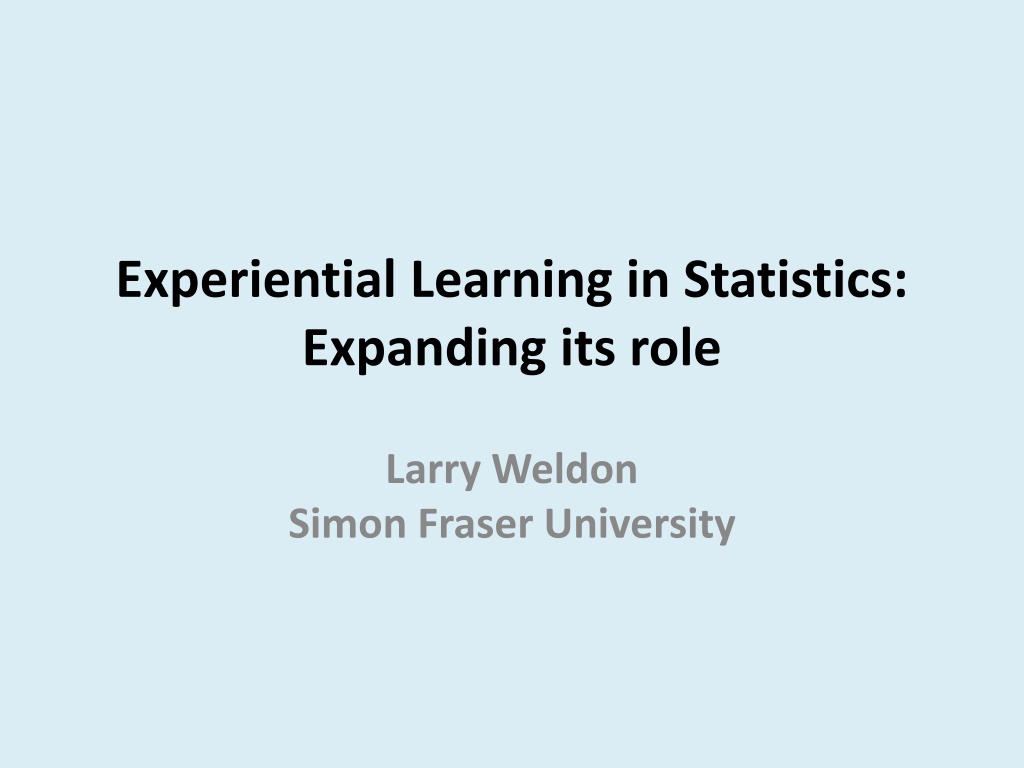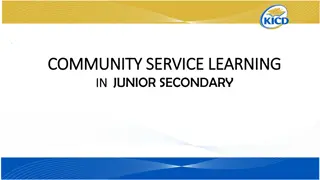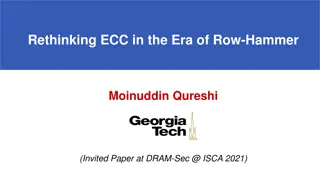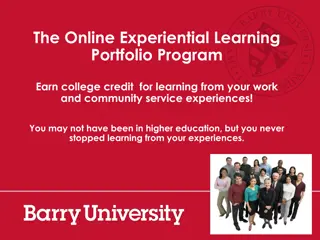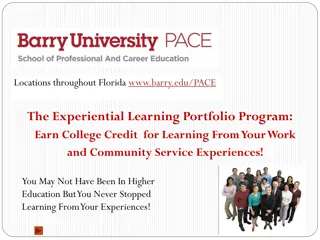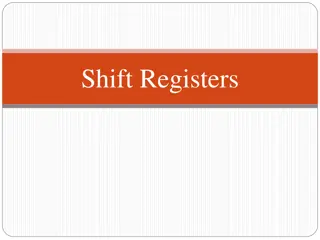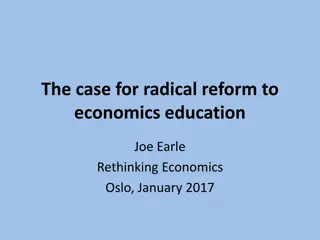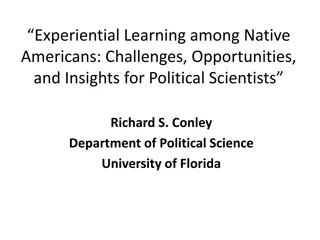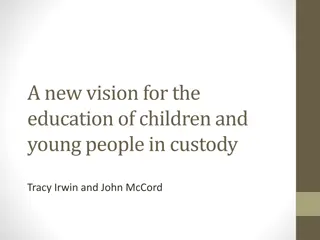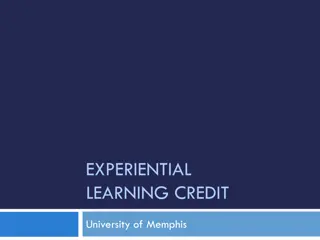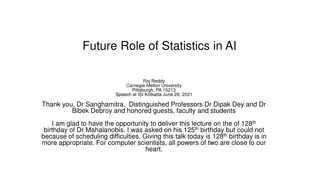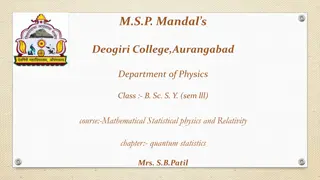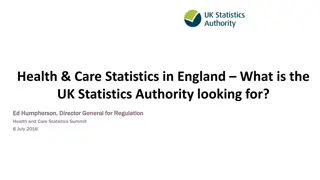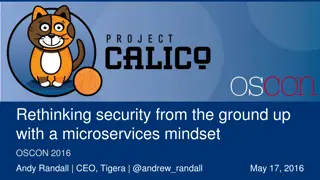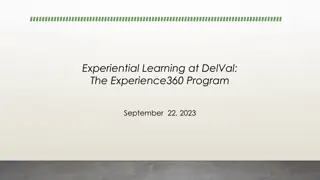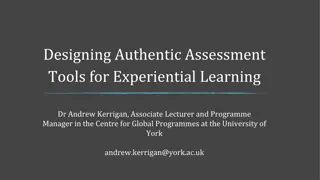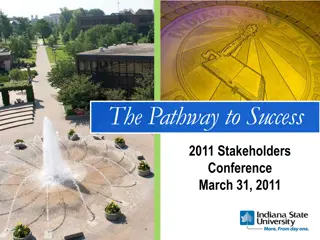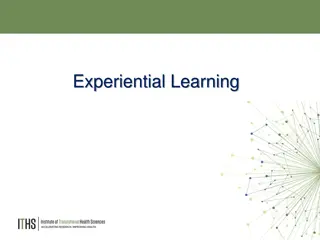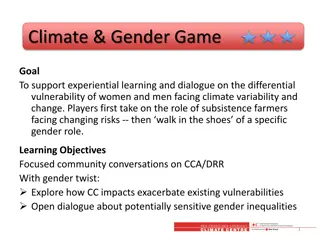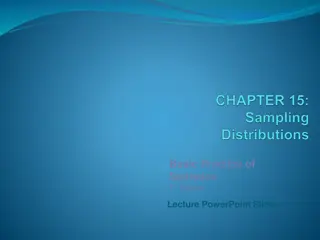Rethinking Statistics Education: A Shift Towards Experiential Learning
Expanding on the role of experiential learning in statistics education, this presentation challenges the traditional approach and advocates for a more practical and hands-on teaching methodology. It questions the emphasis on mathematical rigor over practical application and suggests a new taxonomy for statistics courses to better serve students aiming to become practitioners in the field.
Download Presentation

Please find below an Image/Link to download the presentation.
The content on the website is provided AS IS for your information and personal use only. It may not be sold, licensed, or shared on other websites without obtaining consent from the author. Download presentation by click this link. If you encounter any issues during the download, it is possible that the publisher has removed the file from their server.
E N D
Presentation Transcript
Experiential Learning in Statistics: Expanding its role Larry Weldon Simon Fraser University
Outline Math Roots and Course Taxonomy Calls for Change 1986 and 2009 Examples of Experiential Teaching Features of Experiential Teaching and Learning Implementation Issues
Influence of Math Roots Statistics as a Logical sequence of Techniques e.g. 1 var -> 2 var -> 3 var -> multivariate descriptive -> models -> sampling -> estimation -> hypoth testing probability -> stochastic processes -> time series
Smoothing Graphics Resampling Research Design Nonparametrics Time Series Measurement Model Quality Control Computer Intensive Techniques Where do these fit in? These are not really advanced topics
Influence of Math Roots Have we let our desire for mathematical thinking limit our service to statistics students? Why do we omit useful, simple techniques so that we can cover the traditional inference methods that students find so confusing? Are math students our primary target for stats instruction?
Mainstream Teaching Target for Statistics Courses? Stat majors? Science/Engineering Majors? Future Stat Practitioners?
Traditional Course Taxonomy Appreciation Courses for Liberal arts Service Courses for Practitioners Mainstream Courses for Stat Majors Proportion of students Appreciation Service 80% Mainstream 15% 5% More Math
Main Target of Stats Education? Practitioners! (Really the Mainstream ?) Should stat majors take practitioners courses? Perhaps stat majors need more, not different Appreciation -> Practice -> Expert (New Taxonomy?)
Many Levels One Process The big ideas of statistics can be explained at any level: appreciation, practice, expert Averaging Distribution Randomness Simulation Sampling .... Appreciation -> Practice -> Expert But the mastery of real world application takes experience and practice .
Proposal Define courses by level of experience instead of level of mathematics. Not a new idea!
Calls for Change ICOTS2 - 1986 Jim Zidek (Canada) The development of statistical skills needs what is no longer feasible, and that is a great deal of one-to-one student-faculty interaction Terry Speed (USA) if students have a good appreciation of this interplay [between questions, answers and statistics], they will have learned some statistical thinking, not just some statistical methods.
More ICOTS2 - 1986 John Taffe (Australia) Using the practical model [of teaching statistics] means aiming to teach by addressing such problems in contexts in which they arise. At present this model is not widely used.
Teleport to 2009 Meng (Harvard) re STAT 105 there The central feature of this course is that the materials are organized by real-life topics instead of statistical ones ... The statistical topics are covered whenever they are needed = Experiential Learning
More 2009 Brown and Kass (Harvard) The net result is that at every level of study, gaining statistical expertise has required extensive coursework, much of which appears to be extraneous to the compelling scientific problems students are interested in solving.
Another recent quote (2007) Nolan and Temple-Lang (Berkeley and Davis) We advocate broadening and increasing this effort to all levels of students and, importantly, using topical, interesting, substantive problems that come from the actual practice of statistics.
Decades of Advice Leading to . How far have we advanced? Do we still teach statistics as a sequence of techniques, or do we introduce these techniques as they arise in real-world statistical problems? Time to explore experiential teaching (and learning) even within an undergraduate program.
Examples of Experiential Teaching Example 1: Sports Leagues Example 2: Melanoma Incidence Example 3: Bimbo Bakery (From my SFU courses STAT 100 and STAT 400)
Example 1: Sports League - Football Success = Quality or Luck? August 30, 2024 U of T 18
Leading Questions Does Team Performance (as represented by league points) reflect Team Quality (as represented by the probability of winning a game)? What would happen if every match 50-50? Equal Quality Teams Coin Toss (or computer) simulation . August 30, 2024 U of T 19
Creativity Needed Measurement of League Point Variability? Allowance for quality gradient? Which comparisons most useful? Information Useful?
Stat Theory? Understanding of illusions of randomness Opportunity for Hypothesis Test (via simulation) Need for measures of variability Probability useful for occurred events Invention of Indices sometimes necessary .more in OZCOTS paper Weldon (2008) August 30, 2024 U of T 21
Example 2: Melanoma Incidence Loess Smooth
Analysis of Melanoma Data Remove trend Oscillation (Smoothed Residual) cf Sunspot Cycle (3 yr lag)
What tools and concepts learned? de-trending of time series role of residual plots that have patterns iterative nature of curve-fitting, choice of smoothing level value of general knowledge for data analysis the importance of aspect ratio in graphical displays comparison of two time series the value of exploratory data analysis convenience of loess as a smoothing method the use of timing in relating causation to correlation
Example 3: Bimbo Bakery Bimbo Bakery Multi-national Mexican Company (Orowheat, Bobili, and many other brands) Baked goods time value How many to deliver daily to this retail outlet? sample data: one product, one retail outlet, deliveries and sales for one year (53 x 6 days)
Compare Guess vs Actual mean=100, SD=25 ?
Improved Fit mean=117, SD=40
Optimize Delivery Percentage A s s u m e s N ( 1 1
Criteria for Projects Subject Matter of Interest Context Known or Easily Learned Info Accessible with Next Level Techniques
Features of Experiential Projects Of Interest to Students Using Modern Techniques for Analysis Opportunity for Student Creativity Wide Variety of Techniques Required Linkage of Theory and Context Involving Techniques Useful for Practice ( Authentic Content )
Implementation Issues 3hrs/wk schedule No textbook, Any textbook Assessment Instructor Workload Large Classes Experiential Background of Instructors User Department Requirements Choice of Project Contexts Course Content Coverage Requirement (Rodney Carr Roadmaps next slide)
Conclusion (My conclusion!) Experiential Teaching and Learning may enable students to be better prepared for statistics practice, may provide a more stimulating way to learn, and may change negative attitudes to statistics is feasible now, for small classes (<25)
Comments? Larry Weldon weldon@sfu.ca www.stat.sfu.ca/~weldon
